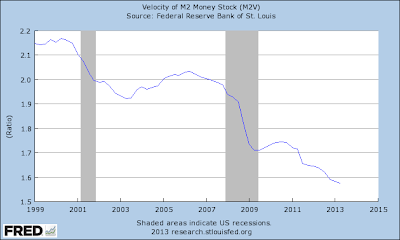After
the Fed’s latest 2-day policy meeting it announced on Wednesday that it would
continue its $85 billion per month asset purchase program. The major indices fluctuated from positive to
negative throughout the day, as is typical of a Fed meeting day, before closing
basically unchanged.
Many
investors wonder why the Fed’s QE3 program hasn’t boosted the economy more than
it has. After all, $85 billion in
monthly asset purchases would be, in a normal economy, inflationary. This isn’t a normal economy, however, and as
we’ve argued many times in past commentaries the deflationary long-term cycles
which are down through 2014 is one reason why inflation remains subdued despite
the Fed’s best efforts.
There’s
another reason why QE3 hasn’t stimulated the economy to the extent that
Keynesians would like to see. It’s just
possible, as one respected economist has suggested, that quantitative easing
was never meant to be stimulative to begin with.
Scott
Grannis, a former chief economist at Western Asset Management and editor of the popular Calafia Beach Pundit
blog, recently wrote that the primary objective of QE was to satisfy the world’s
massive demand for money in the wake of the 2008 credit crash. With the very real prospect of runaway
deflation following the 2008 crisis, the Fed had no choice but to provide as
much liquidity to the financial system as it possible could. This, after all, is the prime object of the
central banks as Grannis points out.
Cash
is king in a deflationary environment, and following the credit crisis the
demand for money exploded as investors liquidated stocks and commodities in a
frantic bid to raise cash. “Strong
demand for T-bills began early in 2008,” observed Grannis. “From late 2007 through mid-2008, the Fed
sold almost its entire holdings of T-bills—about one-third of the Monetary
Base—in an attempt to satisfy the world’s demand for safe assets. But it wasn’t
enough.”
That’s
when bank reserves came to the rescue. Reserves
have since expanded to record levels and although banks are starting to lend
again, most of that surplus money remains unused. As Grannis puts it, “Bank reserves are the
new T-bills, and that's why banks have been content to accumulate $1.9 trillion
of ‘excess’ bank reserves (reserves that are sitting idle at the Fed, and not
being used to support increased lending) since late 2008.
Notwithstanding
the massive increase in bank reserves, money supply as measured by M2 hasn’t
shown an inflationary increase. Velocity
of M2 is in decline and while a record amount of liquidity now exists, little
of that money is seeing the light of day.
See graph below.
Indeed,
the world currently holds 25% more money relative to total spending compared to
six years ago, according to Grannis. He
observes that QE did nothing more than provide banks with the ability to
support the public voracious appetite to hold more money. The excess money created by the Fed, in other
words, has been absorbed in a global savings glut fueled by fear and
uncertainty over the future. This is why
QE hasn’t resulted in the major inflation that many predicted.
True
economic inflation, which is characterized by dramatically rising prices, wages
and rising interest rates, only happens when the supply of money outstrips the
supply of money. So far that hasn’t
happened due to the world’s continued high demand for money. The Fed simply hasn’t been able to churn out
enough money supply to exceed the public’s clamor for it. This in itself is a testament to the
deflationary undercurrents due to the Kress cycles.

